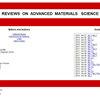土工聚合物和碱活性水泥砂浆/混凝土中超塑化剂的效果:综述
IF 3.6
4区 材料科学
Q2 MATERIALS SCIENCE, MULTIDISCIPLINARY
引用次数: 0
摘要
水泥和建筑行业产生的碳足迹约占全球碳足迹的 10%。土工聚合物和碱活性混凝土为传统混凝土提供了一种可持续的解决方案。由于其缺点,土工聚合物和碱活性混凝土的实际应用非常有限。可加工性是开发土工聚合物和碱活性混凝土所面临的问题之一。为了提高使用不同超塑化剂(SP)的能力,人们进行了大量的研究。本文广泛综述了 SP 对土工聚合物和碱活性混凝土的影响。文章考虑了过去 5 年中发表在高质量期刊上的研究文章,介绍了不同 SP 的化学成分,并分析了它们对土工聚合物和碱活性水泥砂浆和混凝土的确切影响。随后,确定了 SPs 对水泥砂浆的正常稠度和凝结时间、工作性、抗压强度、抗折强度、劈裂拉伸强度、微观结构以及土工聚合物和碱活性混凝土吸水性的影响。在使用所需剂量的 SP 时,SP 可改善土工聚合物和碱活性混凝土的性能;使用更多剂量则会产生负面影响。因此,选择最佳的超塑化剂至关重要,因为它会影响土工聚合物和碱活性混凝土的性能。本文章由计算机程序翻译,如有差异,请以英文原文为准。
Effect of superplasticizer in geopolymer and alkali-activated cement mortar/concrete: A review
The cement and construction industry creates around 10% of the global carbon footprint. Geopolymer and alkali-activated concrete provide a sustainable solution to conventional concrete. Due to its disadvantages, the practical usage of geopolymer and alkali-activated concrete is limited. Workability is one of the issues faced in developing geopolymer and alkali-activated concretes. Plenty of research was conducted to provide a solution to enhance the ability to use different superplasticizers (SPs). The present article extensively reviews the effects of SPs on geopolymer and alkali-activated concretes. The research articles published in the last 5 years in high-quality journals are considered for the chemical composition of the different SPs and analyses of their exact impact on geopolymer and alkali-activated cement mortar and concrete. Later, the impact of SPs on the normal consistency and setting times of cement mortar, workability, compressive strength, flexural strength, split tensile strength, microstructure, and water absorption of geopolymer and alkali-activated concrete was determined. SPs improve the geopolymer and alkali-activated concretes upon their use in desired dosages; more dosage leads to negative effects. Therefore, selecting the optimal superplasticizer is essential since it impacts the performance of the geopolymer and alkali-activated concrete.
求助全文
通过发布文献求助,成功后即可免费获取论文全文。
去求助
来源期刊

Reviews on Advanced Materials Science
工程技术-材料科学:综合
CiteScore
5.10
自引率
11.10%
发文量
43
审稿时长
3.5 months
期刊介绍:
Reviews on Advanced Materials Science is a fully peer-reviewed, open access, electronic journal that publishes significant, original and relevant works in the area of theoretical and experimental studies of advanced materials. The journal provides the readers with free, instant, and permanent access to all content worldwide; and the authors with extensive promotion of published articles, long-time preservation, language-correction services, no space constraints and immediate publication.
Reviews on Advanced Materials Science is listed inter alia by Clarivate Analytics (formerly Thomson Reuters) - Current Contents/Physical, Chemical, and Earth Sciences (CC/PC&ES), JCR and SCIE. Our standard policy requires each paper to be reviewed by at least two Referees and the peer-review process is single-blind.
 求助内容:
求助内容: 应助结果提醒方式:
应助结果提醒方式:


